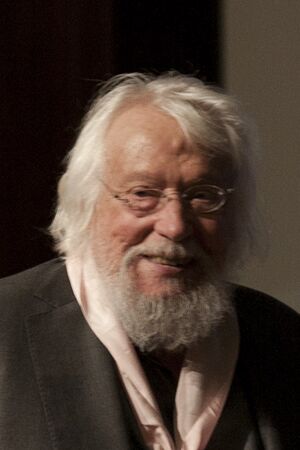Júlio Pomar facts for kids
Júlio Artur da Silva Pomar (born January 10, 1926 – died May 22, 2018) was a famous Portuguese painter and artist. Many people thought he was the best Portuguese painter of his time. He created many different kinds of art throughout his life.
Contents
Becoming an Artist (1940s and 1950s)
Júlio Pomar started his art studies in Lisbon, his hometown. He went to the Superior School of Fine Arts in 1942. That same year, he had his first art show with friends from his old school. A famous artist named Almada Negreiros even bought one of his paintings!
In 1944, Júlio moved to an art school in Porto. He joined a group of artists called the "Independents." He showed his art with them in Porto, Coimbra, and Lisbon.
He also helped promote other artists' work by directing the art page for a newspaper called "A Tarde." He was involved with several magazines too. Around this time, he joined a youth group that wanted to bring social changes to Portugal.
Art for Change: Neo-realism
From 1945 to 1957, Pomar's art became very focused on social and political ideas. This period is called his "neo-realist" phase. Neo-realism was an art style that showed the real lives of ordinary people, especially workers, and often highlighted social problems.
In 1946, he started painting a large mural in a theater in Porto. Sadly, this mural was later destroyed because of its political message. He was also a main organizer for big art shows called the General Exhibitions of Plastic Arts. These shows were important for Portuguese neo-realist painting.
One of his paintings, Resistência (meaning Resistance), was taken by the government police in 1947. They thought it was "politically rebellious." That same year, he had his first solo art show in Porto. He was also arrested for a few months because of his involvement with a group that supported democracy.
His first truly neo-realist painting was Gadanheiro (Mower) from 1945. His most famous work in this style is O Almoço do Trolha (The Lunch of the Trolley). He worked on it from 1946 to 1950. This painting shows the life of a worker and is known for its strong style.
During these years, he also created illustrations and ceramic art. Over time, he became less involved with the neo-realist movement. His last important works in this style were the Ciclo do Arroz (Rice Cycle) paintings, which he made from 1952 to 1955. These were inspired by his trips to rice fields. Around 1956, his art started to go in new directions.
New Artistic Paths (After 1960)
Júlio Pomar moved to Paris in 1963. Even though he was in Paris, he didn't join any specific art groups. He liked to keep his own unique style and explore new ideas. He focused on using strong lines and expressive brushstrokes in his paintings.
In 1967, he started making art using found objects. The next year, he began two new series of works, including one about the big changes happening in May 1968. He continued to show his art in Lisbon and worked closely with Gallery 111, which represented his art in Portugal.
Júlio Pomar was in Lisbon when the April 1974 revolution happened, which brought big changes to Portugal. Throughout the 1970s, he published a book of poems and showed his art in important international exhibitions. He also had his first big show looking back at all his work in 1978, at the Calouste Gulbenkian Foundation in Lisbon and the Soares dos Reis National Museum in Porto.
In his later years, Pomar's paintings often combined surprising images, like tigers and rain hats, or monkeys and portraits. He sometimes looked back to his roots, as seen in his famous painting Lusitânia no Bairro Alto (1985), which includes portraits of other Portuguese artists.
Writings
Júlio Pomar also wrote books. He published three books of essays about painting: Discours sur la Cécité des Peintres (1985), Da Cegueira dos Pintores (1986), and Então e a Pintura? (2003). He also published two books of poetry: Alguns Eventos (1992) and TRATAdoDITOeFeito (2003).
Atelier-Museum Júlio Pomar
The Atelier-Museum Júlio Pomar opened in Lisbon in 2013. It's a special museum that holds hundreds of his artworks, including paintings, drawings, and sculptures. Júlio Pomar himself donated these works to the Júlio Pomar Foundation, so everyone can enjoy them.
Where You Can See His Art
Júlio Pomar's art is displayed in many museums in Portugal and other countries. Some of these include:
- The Chiado Museum in Lisbon
- The Berardo Collection Museum in Lisbon
- The Museum of Contemporary Art of Serralves in Porto
- The Royal Museums of Fine Arts of Belgium in Brussels
- The Museum of Modern Art in Rio de Janeiro, Brazil
- The São Paulo Museum of Art in São Paulo, Brazil
See also
 In Spanish: Júlio Pomar para niños
In Spanish: Júlio Pomar para niños


